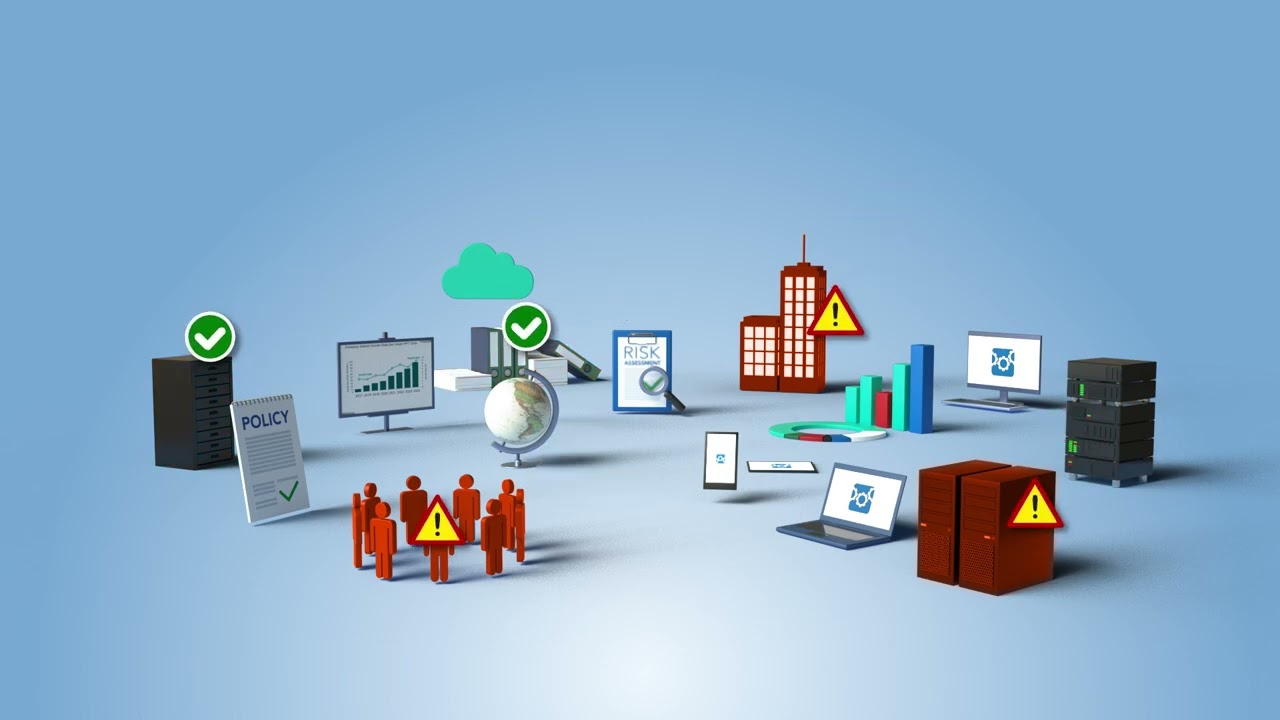Your Roadmap to Risk Reduction!
Table of Contents
ToggleThe Continuum GRC ITAM SaaS platform has hundreds of plugin modules available, such as:

The German Government-backed attestation scheme introduced in Germany by the Federal Office for Information Security (BSI) to help organizations demonstrate operational security against common cyber-attacks within the context of the German Government's "Security Recommendations for Cloud Providers".
Modules include:
- Cloud Computing Compliance Controls Catalog (C5)
- Cloud Computing Compliance Controls Catalog (C5) Preamble
Key Concepts of Cloud Compliance
Cloud security compliance is all about using robust measures to protect sensitive data. This begins with implementing strong governance practices throughout the organization. Internal security controls, like data encryption, are essential, as is ensuring that the organization is always complying with evolving laws and regulations around general data protection.
Cloud services must actively practice IT risk management solutions to identify and address threats; regular audits assure that cloud environments are aligned with the security standards to prevent data breaches, legal or financial exposure, and reputational damage.
Importance of Cloud Compliance
Cloud compliance means an organization is fully aligned with the laws and regulations that ensure that sensitive information is fully protected. Besides keeping data, like that around health insurance portability, secure, being in compliance mitigates any risks associated with data security, such as financial or legal exposure. It’s also important for building confidence among clients and other stakeholders that your organization is ethical and trustworthy in its data protection practices.
Without compliance, an organization may open itself to hefty fines and penalties, as well as serious reputational damage. Maintaining compliance, on the other hand, can be a huge competitive advantage in the marketplace.
Common Types of Cloud Compliance
Cloud compliance refers to several regulatory guidelines that protect different types of sensitive information. Some of the most common types of compliance include:
- HIPAA (Health Insurance Portability and Accountability Act): for securing health and patient information.
- GDPR (General Data Protection Regulation): protects the personal data of EU residents.
- SOX (Sarbanes-Oxley Act): requires financial institutions to implement measures to prevent fraud and ensure accuracy.
- PCI DSS (Payment Card Industry Data Security Standard): ensures security around credit cards and cardholder data.
- FedRAMP: required for federal institutions.
There are various frameworks designed to make implementing the needed security measures within your organization easier.
FAQ
What is compliance risk in cloud computing?
Compliance risk within cloud services means to assess the potential for legal, financial, or reputational harm if an organization is not following industry standards, laws, or internal policies for information security. These may stem from security gaps, data privacy, or an ability to be audited and can seriously harm a company.
How do cloud providers handle data breaches in the EU?
Cloud services in the EU are required to have strict security measures in place, like data encryption. If a data breach occurs, providers must notify supervisors and affected individuals within 72 hours of discovery. Incident reports include details of containment, investigation, and recovery efforts.
What are the types of risks involved in cloud computing?
Cloud environments are subject to a variety of risks. Cybercriminals may hijack an account to steal information. Data breaches may expose information to bad actors. Server crashes or hardware failures may lead to data loss. Malicious actions from disgruntled employees can create vulnerabilities. Incorrect settings can lead to misconfigurations that create security gaps.
What is the shared responsibility model in cloud security?
The Shared Responsibility Model determines who is responsible for different parts of the cloud environment between the provider and the customer. The cloud service provider is responsible for keeping the cloud infrastructure secure; the customer must secure the data and apps that are running within that infrastructure.
What is the role of data security in EU cloud compliance?
EU cloud compliance demands that data is secured through the technical measures required by GPDR. These measures include data encryption, both in transmission or at rest. Access controls should be limited to only authorized personnel. Continuous monitoring is required to check for vulnerabilities and address them as needed.
What is the role of encryption in EU compliance?
The EU requires encryption for all kinds of information security. Encryption is a particularly important part of their GDPR standards, helping organizations ensure confidentiality and data security. Encryption can minimize any damage from a data breach, making it unreadable to anyone unauthorized to do so.
What are you waiting for?
You are just a conversation away from putting the power of Continuum GRC to work for you.
Contact us using the form below or calling us at 1-888-896-6207 for immediate assistance.
About this standard
The Cloud Computing Compliance Controls Catalog (C5) is a German government-backed attestation scheme introduced by the Federal Office for Information Security (BSI) in 2016 and updated in 2020 (C5:2020). It establishes a standardized framework to assess the information security of cloud services, primarily for professional cloud service providers (CSPs), their auditors, and customers, including German government agencies and private sector organizations. Below is a compliance overview of C5 based on its structure, purpose, and requirements.
Purpose of C5
C5 aims to:
- Provide a minimum baseline for cloud security to ensure CSPs meet robust cybersecurity standards.
- Enhance transparency by requiring detailed system descriptions, including data location, jurisdiction, and disclosure obligations to public authorities.
- Assist customers in selecting secure cloud providers and tailoring risk management systems.
- Align with internationally recognized standards like ISO/IEC 27001:2013, Cloud Security Alliance (CSA) Cloud Controls Matrix, and BSI’s IT-Grundschutz Catalogues to avoid redundant audits.
Key Features of C5
1. Structure and Scope:
- The C5:2020 catalog includes 125 criteria across 17 domains, such as organization of information security, physical security, identity and access management, and incident response.
- It covers basic requirements for all CSPs and additional criteria for processing highly confidential data or ensuring high availability.
- Applies to IaaS, PaaS, and SaaS providers, with a focus on both public and private sector use cases.
2. Audit and Attestation:
- C5 compliance is verified through audits conducted by independent third-party auditors.
- Two types of reports are issued:
- Type 1 Report: Assesses the suitability of control design as of a specific date.
- Type 2 Report: Evaluates the operating effectiveness of controls over a specified period (e.g., 6-12 months).
- Audits align with standards like AICPA SOC 2 and ISAE 3000, allowing integration with other compliance frameworks to streamline assessments.
3. Transparency Requirements:
- CSPs must provide detailed disclosures about:
- Data location and jurisdiction.
- Service provision details, including subcontractors.
- Certifications and disclosure obligations to government authorities.
- This transparency helps customers assess compliance with legal requirements, data protection laws, and risks like industrial espionage.
4. Target Audience:
- Initially designed for German government agencies and their partners, C5 has gained traction in the private sector, including small and medium-sized enterprises.
- It serves CSPs, auditors, and customers by providing a standardized, auditable security framework.
Compliance Requirements
To achieve C5 compliance, CSPs must:
- Implement controls across the 17 domains, addressing areas like risk management, encryption, and physical security.
- Undergo regular audits (at least annually for Type 2 reports) by an independent auditor.
- Provide a system description detailing operational and environmental parameters, such as data center locations and legal frameworks.
- Meet both basic and additional criteria for high-security or high-availability scenarios, depending on the services offered.
C5 in Practice
- Adoption: Major CSPs like Microsoft Azure, Google Cloud, AWS, SAP, and Snowflake have achieved C5:2020 attestation, demonstrating compliance through Type 2 reports.
- Integration with Other Standards: C5 builds on ISO 27001, CSA CCM, and IT-Grundschutz, allowing CSPs to leverage existing certifications to meet C5 requirements.
- Customer Benefits: Organizations can use a CSP’s C5 attestation as a foundation for their own compliance programs, but must obtain separate attestations for components built on top of the CSP’s services.
- Availability of Reports: C5 reports are often restricted and available only to customers or prospects under non-disclosure agreements (NDAs).
Recent Developments (C5:2020)
- The 2020 revision expanded the scope to include product safety and security and updated criteria to reflect evolving cybersecurity threats.
- Over a dozen national, European, and global CSPs have received C5 attestations, with adoption growing among smaller providers.
- The framework continues to evolve, with updates driven by advancements in cloud computing and cybersecurity needs.
How Organizations Can Use C5
- CSPs: Demonstrate compliance by obtaining Type 1 or Type 2 attestations and providing transparency to customers.
- Customers: Use C5 attestations to evaluate CSPs, ensuring alignment with data protection laws (e.g., GDPR) and organizational policies. Tools like Continuum GRC can help assess risks and build C5-compliant programs.
- Auditors: Leverage C5’s standardized criteria to conduct consistent, repeatable audits.
Conclusion
The C5 framework is a robust, transparent, and internationally aligned standard for ensuring cloud security. Defining clear security baselines and requiring detailed disclosures helps organizations mitigate risks and comply with legal and regulatory requirements. Its adoption by major CSPs and growing use in the private sector underscore its importance in secure cloud computing. For detailed reports, organizations should contact CSPs directly, often under NDAs, or refer to resources like the BSI website.
Amazing Benefits

